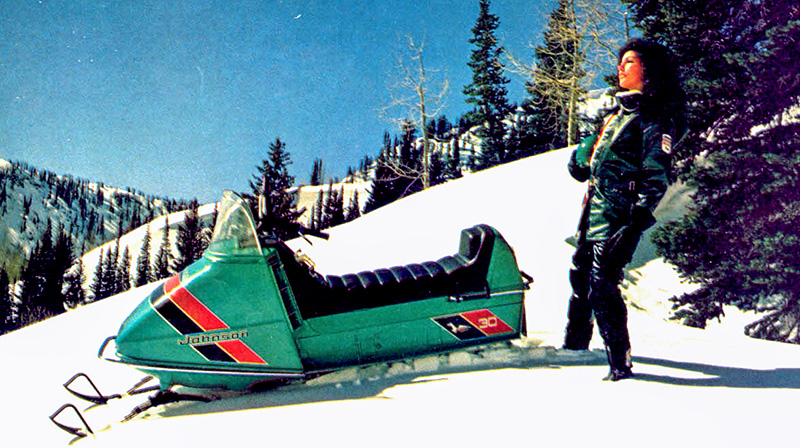 Despite slumping sales during the early 1970s, Sno*Jet tore into the 1975 model year with three SST models redesigned from the track up.
Despite slumping sales during the early 1970s, Sno*Jet tore into the 1975 model year with three SST models redesigned from the track up.
The ‘75 SST F/A 440 clearly was Sno*Jet’s crown jewel. When the Burlington, Vermont, manufacturer brought the sled to Snow Goer’s annual spring test sessions in Colorado, its performance screamed speed and turned heads, according to editors.
“The free-air SST is the best example of raw speed and out-of-the hole acceleration that we’ve laid our hands on in five years of testing snowmobiles,” editors wrote.
On the dyno, editors admittedly were surprised to see how well the SST fared. It got first-place dyno scores in top speed (92 mph), eighth-mile acceleration (10 seconds), quarter-mile acceleration (17.1 seconds) and in the 0-60 mph (7.4 seconds) test.
The improvement over the previous year’s SST was so huge editors joked the dyno had to be broken.
“Enthusiasts familiar with last year’s SST may think that the computer would be due for some repairs. But it’s not,” editors wrote. “It’s well-tuned, functioning perfectly and right on, and so is the brand new SST free air from Sno*Jet.”
On the snow, it reached a top speed of 68 mph – good enough for a tie for first with the speedy Rupp Nitro.
After Snow Goer’s test results were made public in ‘75, performance of the SST F/A 440 was so impressive that Sno*Jet built its entire advertising campaign showing how it clearly dominated the competition.
Redesigned And Ready
The only thing that remained on the 75 SST series was the name.
The heart of the SST was its 433cc Yamaha twin with a Sno*Jet tuned exhaust and high performance aluminum Arctic Enterprises clutching. The first free-air engine from Sno*Jet was unbeatable even by its twin brother housed in the Yamaha GPX under all speed conditions except top speed under a dyno load equal to 5 inches of dry powder, according to editors.
“If you’re primarily interested in speed and if being even second on a trail sets your teeth on edge, the SST is aimed right at your heart,” editors wrote.

Its stability was just as impressive.
“With a tip-over angle of 43.5 and 44.5 degrees left and right, it’ll also forgive if you take one sharp turn too many,” editors wrote.
Contributing to its easy, quick steering were carbide ski runners, and shock absorbers mounted over tapered mono-leaf ski springs to forged steel 1-inch diameter ski legs.
The SST also featured a new, lightweight slide rail suspension – called the Multiflex 75 double rail slider – that transferred weight easier than previous models, according to editors. Idler wheels in the front and rear took weight off the slider shoes and reduced wear while running on hard pack and ice.
Sliders ran over a Sno*Jet built high-profile 15.5- by 115-inch track.
The suspension sat inside a totally redesigned tunnel that allowed a full
10 inches of clearance at the rear for better performance in deep powder and climbing. The tunnel was tapered and all-aluminum for light weight.
The only real complaint editors had with the SST was that the rear suspension occasionally bottomed out during testing.
“That doesn’t matter,” editors wrote. “We’d all bust our butt to win an impromptu race. But, you shouldn’t have to. The Multiflex 75 slide rail features four, four-way adjustments for rider comfort.”
The sled also featured Sno*Jet’s own high performance tuned exhaust and a new muffler that increased performance. A new 8-inch disc brake worked off a converter. Other new features included CDI, easily adjustable handlebars, speedometer, tachometer and a smoke-tinted, pop-off windshield.
The Kawasaki Era
Not surprisingly, Sno*Jet made no major changes the following year, and the ‘76 model still manhandled the competition save for the Nitro, according to editors. Sno*Jet did reach an agreement, though, with Arctic Enterprises of Thief River Falls, Minnesota, to assemble its 76 SSTs.
The big news came in the winter of76 when Kawasaki, a former engine supplier to Arctic Enterprises, acquired Sno*Jet and re-entered the world of snowmobile manufacturing.
A year later, the ‘77 Kawasaki Sno*Jet SSTs underwent some changes, such as a more accessible headlight bulb, re-styled windshield with better protection and a recalibrated suspension for a smoother ride.
Editor’s Note: Every issue of Snow Goer magazine includes in-depth sled reports and comparisons, aftermarket gear and accessories reviews, riding destination articles, do-it-yourself repair information, snowmobile technology and more! Subscribe to Snow Goer now to receive issues delivered to your door 7 times per year for a low cost.








I have a rebuilt 77 kawasaki Snojet. I need to find decals for it. Also the service manual recommends 25 to 1 fuel mixture, is that correct?